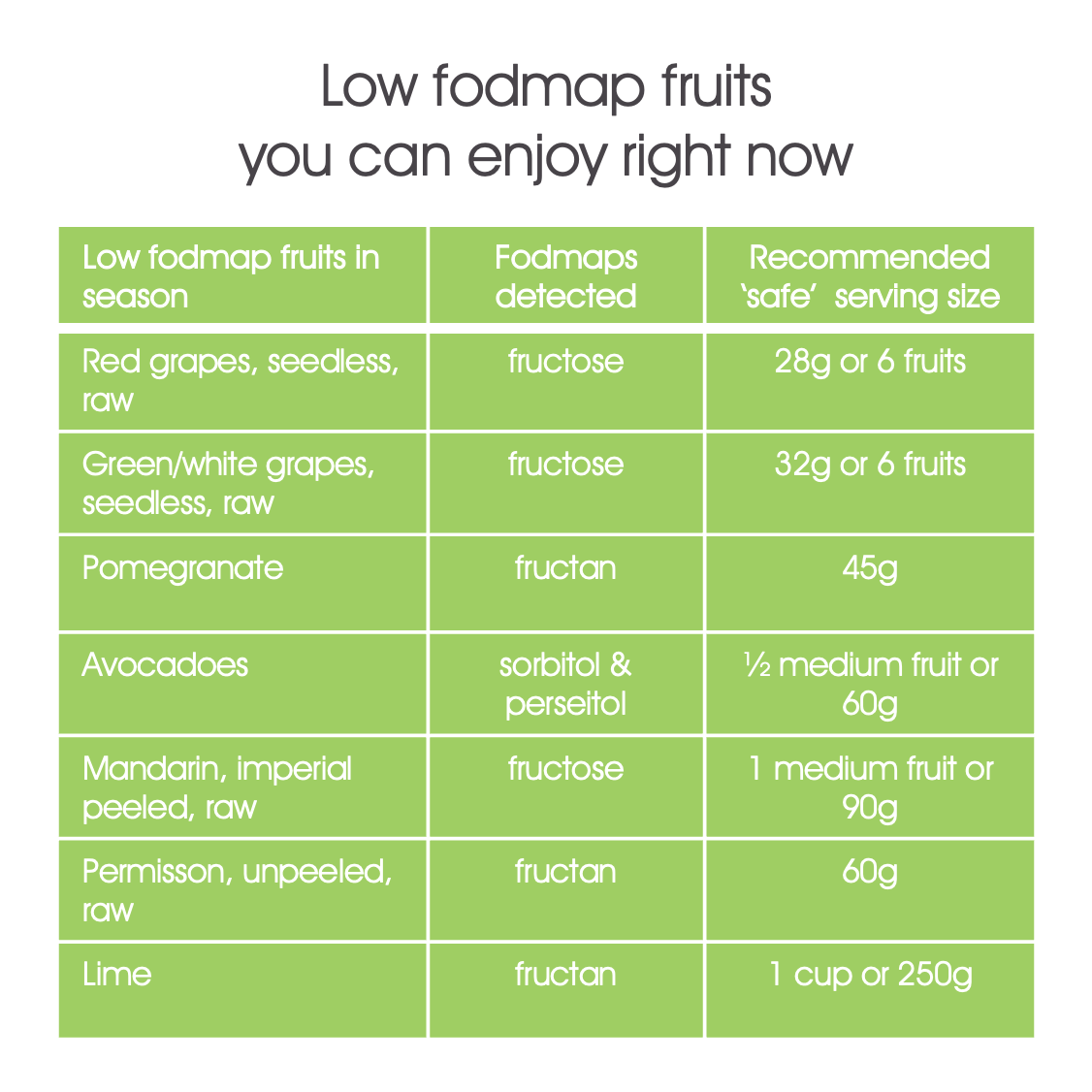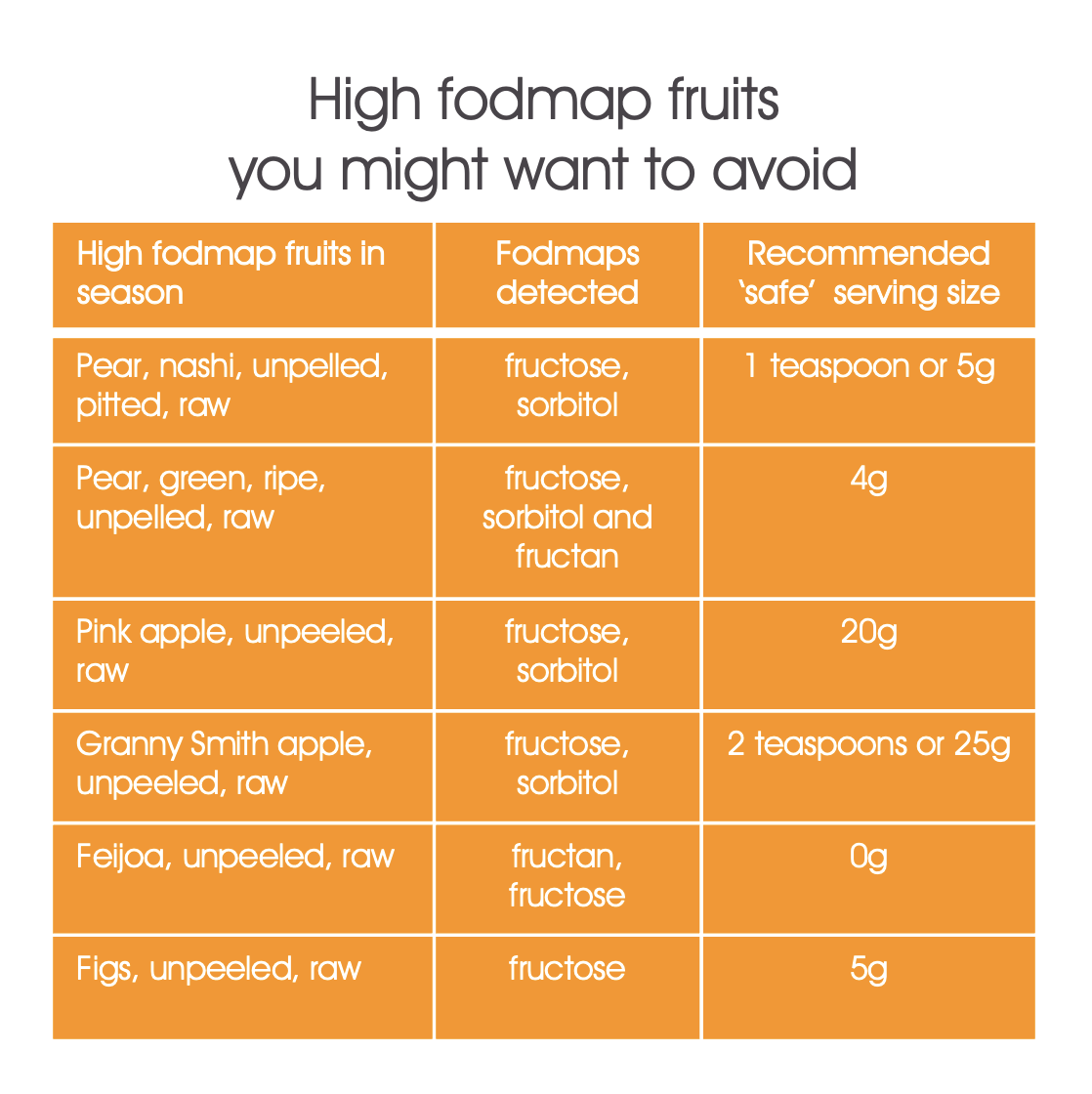Are you struggling to find low fodmap fruit at the moment?
Visiting the farmers’ markets is a joy, except in autumn. Like me, you may find that the low fodmap fruit choices currently available aren’t as enticing as at other times of the years. Those delicious summer-ripened berries have long gone (and the ones that are available are double the price they were a few months ago!)
But don’t despair! We’ve pulled data from the most recent Sydney Fruit, Vegetable and Flowers Market Update (April 2024) and correlated this with the low fodmap serving sizes recommended by the Monash app to let you know what to put in your fruit bowl. While there are lots of not-so-suitable fruits available, more options are coming in season soon!
Navigating low fodmap fruit selection
The FODMAP diet, renowned for its effectiveness in managing symptoms of irritable bowel syndrome (IBS), restricts the intake of fermentable carbohydrates that may trigger digestive discomfort. While many fruits are high in FODMAPs, there are options that are “safe” for consumption, even during the transition into autumn.
But first… let’s get the bad news out of the way first. You’re going to have to walk past a LOT of tempting apples. Bravo, Grannies, Golden Delicious, Cripps Pink and even the long-awaited pink-on-the-inside apples. Most apples are high in fructose and sorbitol, with a recommended low fodmap serving size of 20-30g – the equivalent to 1 tablespoon! So unless you’ve got someone else to share the rest of your apple with, I’d walk past those new-season Bravo apples quickly.
Beurre Bosc pears are also in season, ranging from $3-$4 per kilo. Alas, pears too are high in a range of fodmaps – fructose, sorbitol and fructans. The recommended low fodmap serving size is a mere 4-5g. Once again, walk past those quickly too.
Avocadoes are now in season and have recently been re-evaluated by Monash University’s fodmap team. A serving size of 60g is low in fodmaps and should be tolerated by most people with IBS. However, Monash found that avos contain a unique sugar polyol called perseitol which can trigger symptoms in people who are sensitive to other sugar polyols such as sorbitol so proceed with caution. Keeping the seed intact allows you eat some of the fruit, while keeping the rest fresh for another time.
Feijoa season is short. Which is just as well because they’re high in fructose, even at a 50g serve, so they’re best avoided.
A fabulous assortment of juicy and naturally sweet Aussie table grapes are still in season – with green, red and black-skinned varieties available. The best thing about grapes is that while the recommended low fodmap serving size is low (about 6 grapes per meal), at least you can pick off a few grapes without ruining the whole bunch!
Sweet, succulent figs are still available, but not for much longer. Just as well, because they’re high in fructose and the recommended low fodmap serving size is a measly 5g (or 1 teaspoon). Hopefully they’ll be out-of-mind, out-of-sight soon!
And here comes the good news!
Pomegranates are a favourite addition to classic rice and couscous dishes of the Middle East and ground meat dishes of India and Pakistan. They add sweetness and something special to a dish. Pomegranates are in season now, and the quality is excellent. Expect to pay $1-$5 each. And… the low fodmap serving size is relatively generous at 45g or ¼ cup per meal! This is my family’s favourite roast carrot dish that uses pomegranate as a flavour bomb.
New-season Imperial mandarins are a delicious citrus fruit known for their juicy and fragrant flesh. They are easy to peel, making them a convenient and popular snack option. Not only are they tasty, but they are also a healthy natural source of vitamin C, which helps support a healthy immune system. Pick up a kilo this week for $5-$7; the peak supply occurs from May to September. And drumroll… 1 medium mandarin (around 90g) should be tolerated by most individuals with IBS. Yay!
Sweet persimmons are currently in season and readily available, with prices ranging from $1 to $3 each. A 60g serving size is low in fodmaps and should be tolerated by most individuals with IBS.
Tangy autumn limes are loaded with juicy goodness. The recommended low fodmap serving size is 1 cup (250g) which gives you lots of scope for marinades, salad dressings and sauces.
What to do if you’re feeling fruitilicious?
As the cooler weather sets in, a broader range of citrus fruits will come into their prime, along with gut-friendly kiwifruit, papaya and rhubarb. But how can we enjoy fruit until then? Try these 5 strategies:
1. enjoy small low fodmap serving sizes and store or freeze the leftovers for another day. Lemon juice can stop fruit flesh from browning and keeping the seed intact can help longevity too.
2. choose low fodmap fruit varieties from the freezer. Using frozen mango in this smoothie might not transport you to a tropical island, but at least you can pretend!
3. explore alternative sources of nutrients such as nuts, seeds, lean proteins, whole grains and low fodmap veggies. The dearth in low fodmap fruit will pass.
4. experiment with preservation such as freezing, drying or canning to extend the shelf life of seasonal fruits. Frozen fruits can be used in smoothies, baking, and desserts, while dried fruits can add sweetness and texture to snacks and meals. Just be sure to check the Monash app to ensure that the fodmap content hasn’t changed during the preservation process.
5. consult a fodmapped-trained dietitian. If you're struggling to find suitable low fodmap options, consider consulting a registered dietitian who specialises in gastrointestinal health. They can provide personalised guidance, meal planning strategies, and recipe ideas tailored to your dietary needs and preferences. Here’s a link to the Monash directory so you can find a dietitian in your area.
While the low fodmap fruit options aren’t plentiful at the moment, I like to approach the low fodmap diet with positivity - what fruits CAN I enjoy? And because our microbiome LOVES diversity, even a 20g slice of a crisp Cripps Pink Lady is worth it! And you can make that slither go even further if you pair it with a slice of vintage cheddar cheese. And if the lack of low fodmap variety is really getting you down, maybe it’s time you re-tested your tolerance levels. Maybe you could be enjoying a greater range of fruits right now!
Written by Josephine Muir , PhD - Noisy Guts co-founder, IBS warrior and mum to 2 teens + 3 pets. Fodmap-trained by Monash University. Read more about Noisy Guts here 👉🏽




